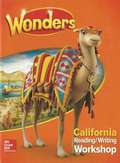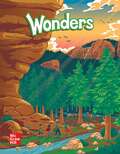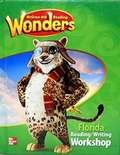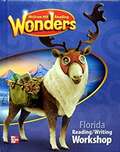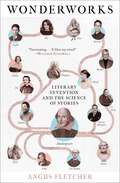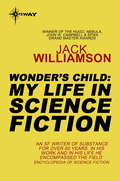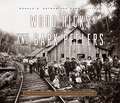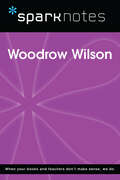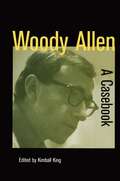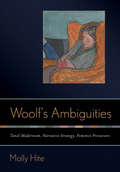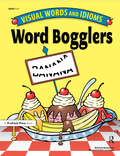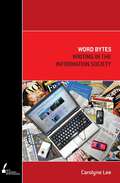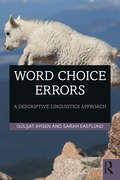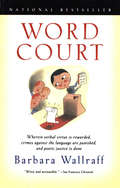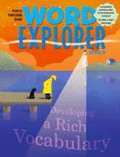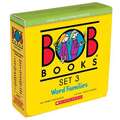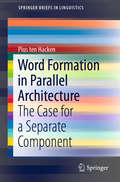- Table View
- List View
Wonders, [Grade 3], Reading/Writing Workshop
by Donald R. Bear Janice A. Dole Diane AugustNIMAC-sourced textbook
Wonders: Reading/Writing Workshop, 4th Grade (Florida Edition)
by McGraw-Hill Staff<p>Unlock the Wonders of Reading! <p>With your Florida Reading/Writing Workshop you will: <p> <li>Talk About New Ideas <li>Read and Reread Exciting Literature <li>Read and Reread Informational Text <li>Look for Text Evidence <li>Access Complex Text <li>Be an Expert Writer <li>Do Your Own Research </p>
Wonders: Reading/Writing Workshop, 5th Grade (Florida Edition)
by McGraw-Hill Staff<p>Unlock the Wonders of Reading! <p>With your Florida Reading/Writing Workshop you will: <p> <li>Talk About New Ideas <li>Read and Reread Exciting Literature <li>Read and Reread Informational Text <li>Look for Text Evidence <li>Access Complex Text <li>Be an Expert Writer <li>Do Your Own Research</li> </p>
Wonderworks: The 25 Most Powerful Inventions in the History of Literature
by Angus FletcherThis &“fascinating&” (Malcolm Gladwell, New York Times bestselling author of Outliers) examination of literary inventions through the ages, from ancient Mesopotamia to Elena Ferrante, shows how writers have created technical breakthroughs—rivaling scientific inventions—and engineering enhancements to the human heart and mind.Literature is a technology like any other. And the writers we revere—from Homer, Shakespeare, Austen, and others—each made a unique technical breakthrough that can be viewed as both a narrative and neuroscientific advancement. Literature&’s great invention was to address problems we could not solve: not how to start a fire or build a boat, but how to live and love; how to maintain courage in the face of death; how to account for the fact that we exist at all. Wonderworks reviews the blueprints for twenty-five of the most significant developments in the history of literature. These inventions can be scientifically shown to alleviate grief, trauma, loneliness, anxiety, numbness, depression, pessimism, and ennui, while sparking creativity, courage, love, empathy, hope, joy, and positive change. They can be found throughout literature—from ancient Chinese lyrics to Shakespeare&’s plays, poetry to nursery rhymes and fairy tales, and crime novels to slave narratives. A &“refreshing and remarkable&” (Jay Parini, author of Borges and Me: An Encounter) exploration of the new literary field of story science, Wonderworks teaches you everything you wish you learned in your English class, and &“contains many instances of critical insight....What&’s most interesting about this compendium is its understanding of imaginative representation as a technology&” (The New York Times).
Wonder’s Child: My Life in Science Fiction
by Jack WilliamsonScience fiction legend Jack Williamson’s classic autobiography is much more than the story of a single man’s life and work; it is an amazing look at the entire 20th century from the perspective of a man on a "long search for endurable compromise with society." Born in 1908, Williamson often felt at odds with the world around him and began writing science fiction as a method of escape. His tentative entrance into the field - his first story was published in 1928 in Hugo Gernsbach’s legendary Amazing Stories - soon transformed him from a pulp writer into one of the Grand Masters of science fiction.
Wood Hicks and Bark Peelers: A Visual History of Pennsylvania’s Railroad Lumbering Communities; The Photographic Legacy of William T. Clarke (Keystone Books)
by Ronald E. Ostman Harry LittellIn Wood Hicks and Bark Peelers, Ronald E. Ostman and Harry Littell draw on the stunning documentary photography of William T. Clarke to tell the story of Pennsylvania’s lumber heyday, a time when loggers serving the needs of a rapidly growing and globalizing country forever altered the dense forests of the state’s northern tier.Discovered in a shed in upstate New York and a barn in Pennsylvania after decades of obscurity, Clarke’s photographs offer an unprecedented view of the logging, lumbering, and wood industries during the late nineteenth and early twentieth centuries. They show the great forests in the process of coming down and the trains that hauled away the felled trees and trimmed logs. And they show the workers—cruisers, jobbers, skidders, teamsters, carpenters, swampers, wood hicks, and bark peelers—their camps and workplaces, their families, their communities. The work was demanding and dangerous; the work sites and housing were unsanitary and unsavory. The changes the newly industrialized logging business wrought were immensely important to the nation’s growth at the same time that they were fantastically—and tragically—transformative of the landscape. An extraordinary look at a little-known photographer’s work and the people and industry he documented, this book reveals, in sharp detail, the history of the third phase of lumber in America.
Wood Hicks and Bark Peelers: A Visual History of Pennsylvania’s Railroad Lumbering Communities; The Photographic Legacy of William T. Clarke (Keystone Books)
by Ronald E. Ostman Harry LittellIn Wood Hicks and Bark Peelers, Ronald E. Ostman and Harry Littell draw on the stunning documentary photography of William T. Clarke to tell the story of Pennsylvania’s lumber heyday, a time when loggers serving the needs of a rapidly growing and globalizing country forever altered the dense forests of the state’s northern tier.Discovered in a shed in upstate New York and a barn in Pennsylvania after decades of obscurity, Clarke’s photographs offer an unprecedented view of the logging, lumbering, and wood industries during the late nineteenth and early twentieth centuries. They show the great forests in the process of coming down and the trains that hauled away the felled trees and trimmed logs. And they show the workers—cruisers, jobbers, skidders, teamsters, carpenters, swampers, wood hicks, and bark peelers—their camps and workplaces, their families, their communities. The work was demanding and dangerous; the work sites and housing were unsanitary and unsavory. The changes the newly industrialized logging business wrought were immensely important to the nation’s growth at the same time that they were fantastically—and tragically—transformative of the landscape. An extraordinary look at a little-known photographer’s work and the people and industry he documented, this book reveals, in sharp detail, the history of the third phase of lumber in America.
Wooden Os
by Vin NardizziWooden Os is a study of the presence of trees and wood in the drama of Shakespeare and his contemporaries - in plays set within forests, in character dialogue, and in props and theatre constructions. Vin Nardizzi connects these themes to the dependence, and surprising ecological impact, of London's commercial theatre industry on England's woodlands, the primary resource required to build all structures in early modern England.Wooden Os situates the theatre within an environmental history that witnessed a perceived scarcity of wood and timber that drove up prices, as well as statute law prohibiting the devastation of English woodlands and urgent calls for the remedying of a resource shortage that was feared would result in eco-political collapse. By considering works including Friar Bacon and Friar Bungay, the revised Spanish Tragedy, and The Tempest, Nardizzi demonstrates how the "trees" within them were used in imaginative ways to mediate England's resource crisis.
Woodrow Wilson (SparkNotes Biography Guide)
by SparkNotesWoodrow Wilson (SparkNotes Biography Guide) Making the reading experience fun! SparkNotes Biography Guides examine the lives of historical luminaries, from Alexander the Great to Virginia Woolf. Each biography guide includes:An examination of the historical context in which the person lived A summary of the person&’s life and achievements A glossary of important terms, people, and events An in-depth look at the key epochs in the person&’s career Study questions and essay topics A review test Suggestions for further reading Whether you&’re a student of history or just a student cramming for a history exam, SparkNotes Biography guides are a reliable, thorough, and readable resource.
Woodward and Bernstein: Life in the Shadow of Watergate
by Alicia ShepardHow the reporters fared after their big story.
Woody Allen: A Casebook
by Kimball KingFirst Published in 2001. Routledge is an imprint of Taylor & Francis, an informa company.
Woolf’s Ambiguities: Tonal Modernism, Narrative Strategy, Feminist Precursors
by Molly HiteIn a book that compares Virginia Woolf's writing with that of the novelist, actress, and feminist activist Elizabeth Robins (1862–1952), Molly Hite explores the fascinating connections between Woolf's aversion to women's "pleading a cause" in fiction and her narrative technique of complicating, minimizing, or omitting tonal cues. Hite shows how A Room of One's Own, Mrs. Dalloway, and The Voyage Out borrow from and implicitly criticize Robins's work.Hite presents and develops the concept of narrative tone as a means to enrich and complicate our readings of Woolf's modernist novels. In Woolf's Ambiguities, she argues that the greatest formal innovation in Woolf's fiction is the muting, complicating, or effacing of textual pointers guiding how readers feel and make ethical judgments about characters and events. Much of Woolf's narrative prose, Hite proposes, thus refrains from endorsing a single position, not only adding value ambiguity to the cognitive ambiguity associated with modernist fiction generally, but explicitly rejecting the polemical intent of feminist novelists in the generation preceding her own. Hite also points out that Woolf reconsidered her rejection of polemical fiction later in her career. In the unfinished draft of her "essay-nove;" The Pargiters, Woolf created a brilliant new narrative form allowing her to make unequivocal value judgments.
Word Art + Gesture Art = Tone Art: The Relationship Between the Vocal and the Instrumental in Different Arts
by Hanns-Werner Heister Hanjo Polk Bernhard RusamThis book offers a truly interdisciplinary discussion on the relationship between the vocal and the instrumental in music and other arts and in everyday communication alike. Presenting an in-depth systematical and historical analysis of the evolution of word and gesture art, it gives extensive information on the anthropological, biological, and physiological influences and interactions in music and beyond. The book gives a unique definition of the genuinely vocal and instrumental from their generative deep structure: They derive from and are determined in their production by the duality of voice and hands, and in terms of product as the tone or ‘tonal’ on the one hand, and the percussive, that is noise plus rhythm, on the other. This book succeeds in bringing together perspectives from art, and from natural and social sciences, merging them to offer new explanations about the relationship between the vocal and instrumental, and eventually about the origins of music, arts, and language. It offers new perspectives on the intertwining between the vocal and the instrumental, specifically in the context of the expressions of human languages. At the same time, this book aims at clarifying and explaining the role of words and gestures in different contexts, such as society and communication, education, and arts.
Word Bogglers: Visual Words And Idioms, Grades 3-6
by Dianne DrazeAre you looking for a motivating way to combine problem solving, visual discrimination, and language? Word Bogglers is just what you need. A word boggler is a puzzle, a brain teaser, and a lesson in language, all rolled into one. These clever visual puzzles use words and phrases to build flexible thinking and word literacy. Each word boggler is a word or phrase that has been written so that its meaning is conveyed via the position, number, or size of the words and letters. Some of the puzzles are words while some are familiar idioms and clichés. Thus, this book brings an opportunity to develop vocabulary and knowledge of often-used phrases in the form of motivating brainteasers. Each page features six of these visual puzzles. Students analyze the way the words are written (size, position, and direction) to solve each boggler and match it with its definition. A way to further reinforce the understanding of each phrase is to have students use the phrases in a written sentence. You can use these puzzles in a variety of ways, including: putting them on the overhead for a quick daily thinking challenge, using them as starting points for daily writing exercises, using an entire page for a weekly challenge, forming groups to work together on solving the puzzles, using them in a learning center, and having students make up their own puzzles. Bring Words Bogglers into your classroom today. The result of using these word puzzles is lots of fun, lots of challenge, and increased knowledge of the meaning of common idioms and words. For more word puzzles, see The World's Greatest Brain Bogglers and Brain Twisters!
Word Bytes: Writing in the Information Society
by Carolyne LeeWords matter. And good writing matters. Especially in the information society, in which more writing than ever is disseminated and read. There may be a lot of dross out there, but we can also find writing that stands out from the rest. It lodges in our heads because of its simplicity and style, and because it says something worth reading. This is 'word byte' writing, a term that Carolyne Lee coins, defines and explains in this book, and which she and her contributors encourage their readers to achieve. A wide range of genres of public and professional writing; including magazine profiles, newspaper articles and blog posts; is covered in Word Bytes. The contributions from other professional writers, magazine and newspaper journalists through to a blogger and web-editor, will inspire and teach all those who want to learn to recognise and produce word bytes; writing that gets noticed and read in a world of information overload.
Word Cards, Grade K (Into Reading, Read Aloud Module 10)
by Houghton Mifflin Harcourt Publishing CompanyNIMAC-sourced textbook
Word Cards, Grades 1 and 2 (Into Reading, Read Aloud Module 3)
by Houghton Mifflin Harcourt Publishing CompanyNIMAC-sourced textbook
Word Choice Errors: A Descriptive Linguistics Approach
by Gulsat Aygen Sarah EastlundAmerican English has many word pairs and trios that are alike enough to be confusing. Word Choice Errors provides a novel way to empower writers of all levels to cut through the confusion to understand which word to use and why that’s the word to use. Written in a user-friendly style, grounded in descriptive linguistics methods, and eschewing memorization, this book trains writers to detect, interpret, and act on language clues – with exercises, "wild idea" analytical tricks, and additional resources throughout. It is an excellent resource for instructors and students of grammar or writing/rhetoric, as well as for individuals looking to develop their language and writing skills.
Word Court: Wherein verbal virtue is rewarded, crimes against the language are punished, and poetic justice is d
by Barbara WallraffIn 1993, the Atlantic Monthly's senior editor Barbara Wallraff began answering grammar questions on America Online. Instantaneously the site became one of AOL's most popular forums, as questions, and responses to Wallraff's responses, came flooding in. This vibrant exchange became the bimonthly "Word Court" in the Atlantic Monthly, and the "Miss Manners of Grammar" was born. In Word Court, Wallraff moves beyond her column to tackle common and uncommon items, establishing rules for such issues as turns of phrase, slang, name usage, punctuation, and newly coined vocabulary. With true wit, she deliberates and decides on the right path for lovers of language, ranging from classic questions-is "a historical" or "an historical" correct?-to awkward issues-How long does someone have to be dead before we should all stop calling her "the late"? Should you use "like" or "as"-and when? The result is a warmly humorous, reassuring, and brilliantly perceptive tour of how and why we speak the way we do.
Word Explorer: Developing a Rich Vocabulary (Level D)
by Peoples Education StaffA workbook for improving student vocabulary.
Word Families (Bob Books Set #3)
by Bobby Lynn Maslen John R. MaslenBob Books Set 3 adds something new for young readers. Consonant blends gently introduce new concepts to the progressing reader. Consistent vowel sounds and lots of three-letter-word practice mean your child continues to enjoy reading success. In addition to eight story books, two Activity Books are included, designed to entice youngsters to read, write, and solve puzzles.
Word Formation in Parallel Architecture: The Case for a Separate Component (SpringerBriefs in Linguistics)
by Pius ten HackenThis book aims to reconcile the generative considerations of Jackendoff’s Parallel Architecture (PA) with the European structuralist approach to naming. It shows that there are good reasons to single out word formation as a separate component in PA. It demonstrates that it is a drawback not to distinguish word formation, and explains that the function of word formation rules is different from the function of the lexicon and rules of grammar. After making the argument for a separate word formation component, the book sets out to determine which types of rule qualify as part of this component. Traditionally, the boundaries of word formation with inflection and with syntax have been a matter of debate. By focusing on the naming function, the book poses a guiding principle for determining which rules should be in the word formation component. The position of morphology in the architecture of grammar has always been an issue of debate in generative linguistics. Since Chomsky (1970), this question has been framed in terms of the Lexicalist Hypothesis. Compared to Chomsky’s architectures, Jackendoff’s Parallel Architecture places phonetic and conceptual structures at the same level as syntactic structure, i.e. connected by bidirectional linking rules rather than interpretation rules. One of the consequences is that PA does not formally distinguish lexicon entries from rules of grammar. This changes the setting for the question of the autonomy of morphology, because the Lexicalist Hypothesis depends on this distinction.

